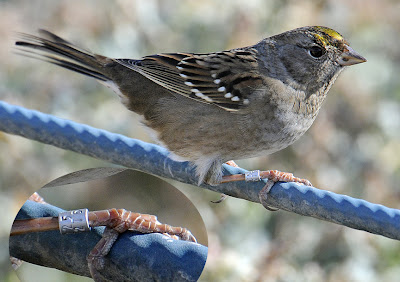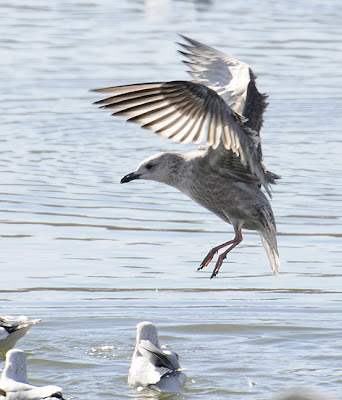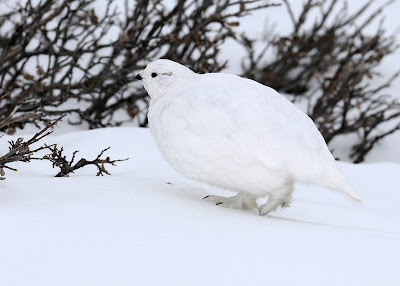

Bill Schmoker's Nature & Birding Blog



 That's not the case anymore! I just got a review copy of iBird Explorer in the Backyard and Plus versions for iPhone- their simplest and most inclusive, respectively (iBird Explorer also comes in a Windows Mobile version.) iBird Explorer Backyard has 145 species and is marketed at casual birders, while Plus covers 891 bird species for us serious folks. iBird also comes in several regional packages- West, Midwest, North, South, and Canada. I'll profile it a bit more in my next Geared for Birding column in Winging It (The American Birding Association's newsletter), but at a quick glance this is a very cool app. Here's what their features page lists, with a few of my comments:
That's not the case anymore! I just got a review copy of iBird Explorer in the Backyard and Plus versions for iPhone- their simplest and most inclusive, respectively (iBird Explorer also comes in a Windows Mobile version.) iBird Explorer Backyard has 145 species and is marketed at casual birders, while Plus covers 891 bird species for us serious folks. iBird also comes in several regional packages- West, Midwest, North, South, and Canada. I'll profile it a bit more in my next Geared for Birding column in Winging It (The American Birding Association's newsletter), but at a quick glance this is a very cool app. Here's what their features page lists, with a few of my comments: ■ Plays the songs and calls of almost any species of bird in North America. And it’s loud enough to attract the bird right to you! (Use responsibly! To their credit, iBird Explorer's web site includes the ABA Code of Birding Ethics.)
■ A visual icon-driven search engine for identifying species by color, shape, habitat, location, etc. (Cool concept- haven't tested it much yet, though.)
■ Hand-drawn James Audubon quality full-sized color illustrations with both perching and flight views (Well, John James wouldn't be my first choice of comparison, but we get the idea...)
■ Multiple professional photographs of every species in numerous plumages, sexes and seasons (Nice idea, and an area that should grow in future releases. Will this end the age-old arguments of illustrations vs. photos in a field guide?)
■ Identification and behavior information so extensive it covers everything from what the bird eats to the color of the eggs it lays (A little Birds of North America-style info- always good. Speaking of which, how about a BNA app??)
■ Full color range maps for every species (Did Paul Lehman have a hand in these, too?)
■ Detailed Wiki pages for every bird (Welcome to Web 2.0!)
■ Lifetime updates (you never need to buy another guide because we push out any changes we make for free) (Could be the single best feature of guides like this vs. paper books.)
 Other planned upgrade features:
Other planned upgrade features:■ Additional illustrations covering other plumages including seasonal, fledgling, juvenile, etc. (The more the merrier. Wonder if Sibley &/or Kaufman are thinking about this format?)
■ Many new photographs. (Can you ever have enough?)
■ Sighting/Observation list feature based on eBird.org. You’ll be able to record all the details of any observation or sighting then upload it to the popular eBird database where you can have your own account. (I think this is a must-have feature on any web-enabled smart phone or Windows Mobile device!)
■ Synchronization with Whatbird.com user accounts. (Don't know what this is but I'm sure users will be happy.)
■ Quizzes and identification tests, puzzles and word games. (I'm all for anything that might engage kids more or make road trips a little less boring.)

 My team of hardy birders (below, from left: Yours Truly, Connie Kogler, Dave Alcock, Mike Freiberg, and Dan Maynard) went up in the Boulder foothills to an open space park called Betasso Preserve. Our second bird of the day also turned out to be our best- a very chilly Brown Thrasher subsisting on Russian Olive berries bordering a horse corral. Beyond that the birding was kind of slow but we had some nice montane species and it was priceless to walk a 3-mile loop in a typically busy mountain park with the only tracks before us in the snow belonging to deer, squirrels, and rabbits.
My team of hardy birders (below, from left: Yours Truly, Connie Kogler, Dave Alcock, Mike Freiberg, and Dan Maynard) went up in the Boulder foothills to an open space park called Betasso Preserve. Our second bird of the day also turned out to be our best- a very chilly Brown Thrasher subsisting on Russian Olive berries bordering a horse corral. Beyond that the birding was kind of slow but we had some nice montane species and it was priceless to walk a 3-mile loop in a typically busy mountain park with the only tracks before us in the snow belonging to deer, squirrels, and rabbits.

 Once we wrapped up in the mountains, we descended to warm up, re-group, and get a bite to eat at The Original Pancake House in Boulder. The host took pity on us and produced a huge complimentary apple pancake to nosh on while waiting for the rest of our orders.
Once we wrapped up in the mountains, we descended to warm up, re-group, and get a bite to eat at The Original Pancake House in Boulder. The host took pity on us and produced a huge complimentary apple pancake to nosh on while waiting for the rest of our orders. Re-stoked and warmed up, a few of us headed back out to surmount the mesa in the midst of the Valmont Reservoir complex, lakes warmed by a power plant nearby and often chock-full of great birds. Divers like Double-crested Cormorant and Western Grebe overwinter here in small numbers, the only location in the count circle for such species that would normally depart for warmer climes. Unfortunately, the combination of relatively warm water and very cold air (about -5 F by then) produced very foggy conditions. Still, we gave it a go, sometimes glimpsing birds through quick gaps in the fog like a raft of about 75 Red-breasted Mergansers. Earlier in the day, a team had covered the territory from inside the fenced complex (permission and chaperone required from Xcel Energy) but had missed seeing any of the Western Grebes that should have been out in the fog. Fortunately, from our higher vantage we could hear at least one give its kree-kreeee call- tick it!
Re-stoked and warmed up, a few of us headed back out to surmount the mesa in the midst of the Valmont Reservoir complex, lakes warmed by a power plant nearby and often chock-full of great birds. Divers like Double-crested Cormorant and Western Grebe overwinter here in small numbers, the only location in the count circle for such species that would normally depart for warmer climes. Unfortunately, the combination of relatively warm water and very cold air (about -5 F by then) produced very foggy conditions. Still, we gave it a go, sometimes glimpsing birds through quick gaps in the fog like a raft of about 75 Red-breasted Mergansers. Earlier in the day, a team had covered the territory from inside the fenced complex (permission and chaperone required from Xcel Energy) but had missed seeing any of the Western Grebes that should have been out in the fog. Fortunately, from our higher vantage we could hear at least one give its kree-kreeee call- tick it! I'd like to thank everyone who braved the cold to participate in the Boulder CBC. We were able to add one new species to the all-time list (bringing it to 206) with a Great Black-backed Gull, and other highlights included Western Bluebird & the aforementioned Brown Thrasher (each the 11th time on count day), Lesser Goldfinch (9th time), Eared Grebe & Hermit Thrush (each for the 5th time), Lesser Black-backed Gull (4th time), and Brown-capped Rosy-Finch (3rd time, complimenting Gray-crowned's 14th appearance.) Next year will be the 100th aniversary of the Boulder count, which was first run on Dec. 24, 1909. It's going to be big so make plans to join us on December 20, 2009! Meanwhile, there's plenty of time to join another count this year- you can find one on Audubon's Find a Count Circle page.
I'd like to thank everyone who braved the cold to participate in the Boulder CBC. We were able to add one new species to the all-time list (bringing it to 206) with a Great Black-backed Gull, and other highlights included Western Bluebird & the aforementioned Brown Thrasher (each the 11th time on count day), Lesser Goldfinch (9th time), Eared Grebe & Hermit Thrush (each for the 5th time), Lesser Black-backed Gull (4th time), and Brown-capped Rosy-Finch (3rd time, complimenting Gray-crowned's 14th appearance.) Next year will be the 100th aniversary of the Boulder count, which was first run on Dec. 24, 1909. It's going to be big so make plans to join us on December 20, 2009! Meanwhile, there's plenty of time to join another count this year- you can find one on Audubon's Find a Count Circle page.













 And here are a couple of flight composites:
And here are a couple of flight composites:






Noah Strycker is spending this season in a field camp on remote Cape Crozier, Antarctica, with two other researchers and several hundred thousand Adelie Penguins. Adverse weather, cramped conditions, and isolation are usual. This blog covers day-to-day life on earth's driest, coldest, windiest, most southerly continent.
Noah is a 22-year-old recent graduate of Oregon State University in Fisheries and Wildlife. He is Associate Editor of Birding magazine, columnist known as BirdBoy in WildBird magazine, and a passionate birder, artist, and photographer. Contact him or see more of his work at noahstrycker.com.
Penguin Science research is ongoing. You can learn more about the project at penguinscience.com.

















